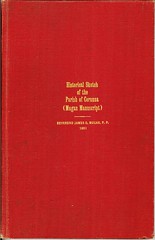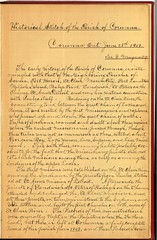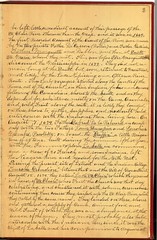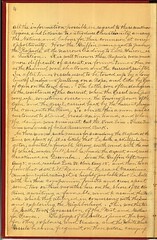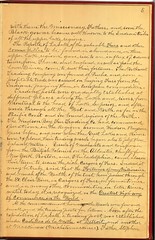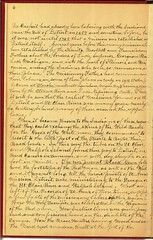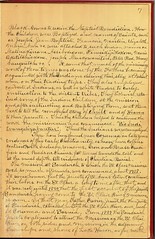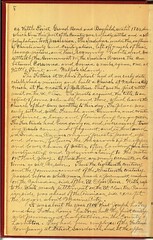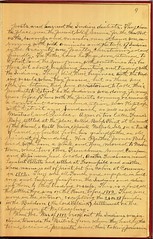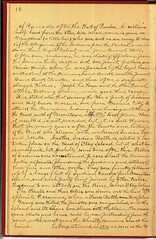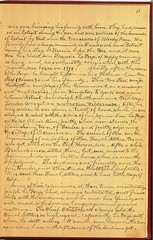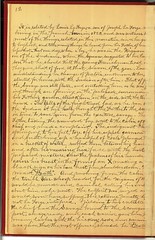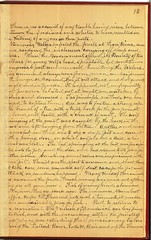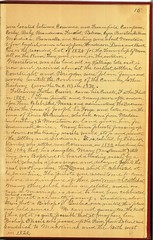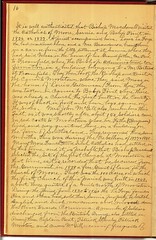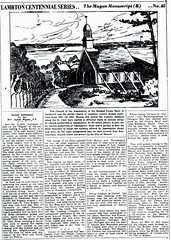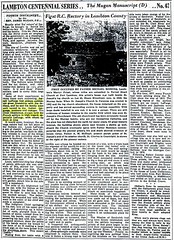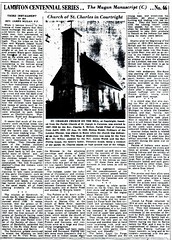These are images of the physical book that was provided to the Sarnia Historical Society by the Diocese of London. We wrote about our visit there in our blog.
Here is the paper article of the Manuscript from 1949
Page 01The early history of the parish of Corunna is intermingled with that of the neighboring parishes of Sarnia, Port Huron, St. Clair, Marine City, Port Lambton, Walpole Island, Baby’s Point, Sandwich, St. Peter’s on the Thames, St. Ann’s Detroit, and even has historic connection with Quebec City itself. Bordering on the St. Clair River, the connecting link between the great chain of Lakes and Rivers, it was visited by the first Missionaries and Explorers, who passed up and down the great chain of waters.
Tribes of Indians roamed and dwelt about these regions when the earliest missionaries passed through, though these tribes were not so numerous as those settled about Georgian Bay, Lake Huron, Lake Superior and Michigan. This with their roaming habits probably accounts for the fact that the missionary priests did not establish missions among them as early as among the Indians of the Upper Lakes.
The first missions were established on the St. Clair River among the Indians by the priests from Quebec stationed at St. Ann’s mission of Detroit. Afterwards the priests of Sandwich + St. Peters of Raleigh on the Thames attended and enlarged the St. Clair Missions and all of those priests in turn ministered to the Indians and white settlers and built the first Churches on both sides of St. Clair River. The Records of their ministrations were generally kept in the Registers where the Fathers lived, but there is kept in Corunna a fairly complete record of this parish from 1848, and these records con
Page 02
contain also considerable accounts of the missionary labors of the same priests, during the eight years after this date, in all of the missions on both sides of the St. Clair River and in the adjourning Townships. There are also a few leaves and inscriptions left recording certain events back to 1839. The events related in this sketch previous to that date are taken from the records of the above named parishes, or learned from witnesses still living and from well-remembered accounts of their Fathers who were the earliest settlers of the Township. Many references in other records and histories shed much light on this narrative.
The Parish of Corunna as it is at this date (June 1, 1901) consists of the Township of Moor about 10×12 miles fronting on St. Clair River. The Parish church built in 1862 by Father Boubat and the Priests residence built in 1873 by Father Watters are at Corunna on the river bank. The mission church is at Courtright 5 miles south, also overlooking the river. The village of Mooretown is near the site of the first church built in 1843, half way between Corunna and Courtright.
To trace the development of this parish from the dawn of Christianity on the St. Clair River to the present it is necessary to go back quite an early date. While the Provence of Ontario and the State of Michigan were yet slumbering beneath their primeval forests, and the Red man roaming over those rich hunting grounds, the broad sails of the trading vessels, with their cargos of fur and the light canoes of the Indians, were bearing the Missionary Fathers to and fro over the placid waters of the St. Clair River. The Jesuit Fathers had in 1660 traced a map of the chain of Lakes and Rivers from Lake Erie to Lake Superior, show that they had already passed through Detroit and St. Clair Rivers at that early date. There seems to
Page 3
be left, little, or no direct account of their passage of the St. Clair River otherwise than the map, and it was in 1669, the first recorded account of the ascent of the river was made by the two priests Father
DeCasson (Dollier) and Father Gallinée. Fathers Marquette and Dablon were then at Sault Ste Marie, whom they met. This was before Pere Marquette discovered the Mississippi in 1673. They did not remain long at the Sault, but soon returned to Montreal, most likely, by the Lake Nipissing and Ottawa River Route. These early voyages skirted along the bank of the rivers out of the current, in their Indian fashioned canoes following the Canadian shores to the Sault, and as they depended for sustenance mostly on the game, animals and wild fruit along the route, it is likely they landed on the shores to gather supplies and no doubt held intercourse with the Indians then living here. On August 7, 1679 Father Gabriel De la Ribourd in company with the two Fathers Louis Hennepin and Zenobius Membreé Recollects on board the “Griffin,” a little Brigantine of 45 tons, built during the summer of that year, with the famous explorer Lasalle in command and a crew of 21 French and some Indians, left the Niagara River and headed for the North-West.
Passing the present site of Detroit and the Indian Village “Teuscha Grondion” between that and the site of Grosse Point, August 12, 1679, they entered “Lake Ste Clair” which they named in honor of “Ste Claire” who’s Feast the church was that day celebrating, and Christened it with solemn ceremonies continuing their course they sailed up the Ste. Clair River which they called by the same name. They landed on the shores and gathered a supply of game, animal food and wild fruit of which there was an abundance at that season of the year. They most probably also held intercourse with the Indians here since it was the object of La Salle and his companions to acquire all
Page 4
the information possible in regard to these unknown regions, and likewise to introduce Christianity among the natives and labour for their conversion at every opportunity. How the Griffin managed to pass up the “Rapids” at the narrows leading to Lake Huron is a question. It is well known these Rapids were much more difficult of ascent in former times than now as the channel was shallower and the current swifter.
In after times vessels used to be towed up by a long lines of Indians pulling on a rope and later by young oxen on the towline, the latter was often dangerous as the resistance of the current when the vessel was part way up, sometimes overcame the towing power of the oxen and the vessel carried back by the current, dragged the oxen into the river. To obviate this a man was accustomed to stand, broad axe in hand and when the danger was eminent cut the towline. These towlines were made of boiled basswood bark.
As there was no such means for ascending the Rapids at the time we speak of it is likely that LaSalle, a skillful navigator, awaited a favorable strong south wind with the aid of which under full sail he made the ascent and reached Mackinac in December. Since the Griffin left Niagara August 7 and reached Lake St. Clair August 12 and then took from that date until December to reach Mackinac (Hennepin English Edition) it is highly probable that LaSalle with his three companion priests and crew spent some two or three months here on the shore of St. Clair River awaiting a favorable wind to ascend the Rapids which they utilized in conversing with the Indians and exploring the neighborhood. This was the time LaSalle took possession of the West and Northwest for France. The voyage of La Salle opened the way for other explorers and traders and the white sailed vessels became frequent on these waters carrying
Page 5
with them the missionary Fathers, and soon the black gowns became well-known to the Indian tribes of all the upper lake regions.
The reports, of La Salle, of the valuable furs and other commodities to be found in abundance in these upper Lake regions gave rise to an influx of adventures from France and England as well as from the lower Province, come to seek their fortunes. The Northwest Trading Company was formed at Quebec and soon a profitable trade was carried on buying furs from the Indians paying them in European commodities.
Trading posts were gradually established at different places along the lakes and rivers from Montréal to the head of Lake Superior and afterwards through all the West and North as far as the Pacific Coast and icebound regions of the North. The Hudson Bay Fur Trading Company had commenced operations in the regions around Hudson Bay some years before and now when the great lakes and rivers were explored, their trading vessels began also to ply these inland waters. Vessels of merchants and companies from the British colonies on the Atlantic, Chiefly from New York, Boston, Philadelphia, came also in their turn to secure the rich cargoes of furs. Indeed it may be truly said that the fortunes of many millionaires and much of the wealth of the East have passed through the St. Clair River in cargoes of furs in former times and in many other commodities in later times, until today it is recognized as the greatest highway of commerce in the world.
At the commencement however the vessels were few and small and a trading post far between. Soon after the expedition of La Salle a trading post was established under Cadillac de la Mothe at Detroit and another at Mackinac (Michilimackinac),
Page 6
Father Stephen DeCarheil had already been laboring with the Indians near the site of Detroit in 1687 and sometime before, but it was not until 1702 that a mission was established at Detroit itself. Several years before this many missions have been established by the Jesuits, Recollect and Franciscan Fathers about the borders of Lake Superior, Georgian Bay, Lake Michigan, and into the heart of Illinois and Wisconsin, among the Indians who were so numerous in those places. The missionary Fathers had commenced their labors and some of those places as early as 1615 (Father Joseph LeCaron at “Otoucha” near Penetanguishene, Georgian Bay) having reached them by the Ottawa River and Lake Nipissing Route. Thus it will be seen that the earliest missions formed on Detroit and St. Clair rivers were many years-nearly 3/4 of a century-behind many of those around the upper lakes.
When it became known to the Indians of these regions that they could exchange the skins of the wild beasts for the goods of the white man, they commenced to resort to the little post on the straits to barter their back-loads. In this way the tribes on the St. Clair and walpole island found their way to Detroit in bark canoes in summer and with dog sleighs or on foot in winter. The ever present black-gown follow the footsteps of the red man as well as the white and it was not long until the heroic priests of St. Anne’s mission, Detroit were ministering to the savages on the St. Clair River and Walpole Island. What are the left of the records of St. Anne’s of those times supply a few facts of the missionary labors in this region.
How the holy sacrifice was collected in the wigwams of the red man. How instructions were given, prayer said, and confessions heard in the dialects of the savages. How the Brave hunters having wooed and won the dark-eyed madens, knelt at the feet of the
Page 7
Black-Gowns to receive the nuptial benediction. How the children were baptized and names of Saints, such as Joseph, John Baptiste, François, Martin, Elizabeth, Mary, Anne, etc were attached to such Indian names as NatinaKinam, Assibodigone, Pinesikijikokone, Marie Aketitchickone, Jospeh Nuskowanitin, Peter Rod, Henry Saugoutche, etc. It seems that much of the missionary work of those times was done by the Fathers becoming acquainted with the Indians during their stay at Detroit when on their trading trips. They also employed converted Indians as well as white traders to carry instruction to the district tribes. They likewise retain some of the Indian children at the mission and after instructing and baptizing them sent them back to tell the wonderful story of Christ and of heaven of their parents. Thus the children helped to continue the work the missionaries had commenced. “Sic Indi evangelizabantur.”
“Thus the Indians were evangelized.”
There have been found near Corona in late years evidences of this early Christianity as heavy hewn coffins containing with Indians remains, iron and brass crucifixes and beads on chains, feet turned towards the east and at the usual depth, all evidences of Christian burial.
The mission at Sandwich to which the St. Clair missions owed so much afterwards, was commenced about 1728. It seems however that the priests of St. Anne’s Detroit continued their labors on the St. Clair a long time after that and it was not until 1827 that the first account of the priests of Sandwich, having come to the St. Clair River missions is given. In that year Father Crevier Jesuit, the then pastor of Sandwich, extended his labors up the St. Clair River and reach Corunna and Sarnia. From 1827 the Sandwich priests continue to attend the missions on the St. Clair River on both sides and missions in the adjourning townships and shores of Lake Huron as far north
Page 8
As Kettle Point, Grand Bend and Bayfield until 1854 during which time this part of the country was rapidly settled and a white population took possession. The Indians under the influence of Christianity and civilization, left off much of their savage nature and their roaming habits, and were settled by the government on the Indian reserves. The one between Corunna and Sarnia 4 miles square, one at Kettle Point and Walpole Island.
The Fathers at St. Anne’s Detroit had an early date established in mission and built a church at Marine City Mich, at the mouth of Belle River. That was the first settlement on the St. Clair. The priests acquired the title to an extent of some valuable land there, which leaves the church of that town wealthy to this day. The place was early settled with French and Germans and continues since a large and flourishing congregation. The fur trade have been going on and increasing, trading vessels came more frequent and in these and in Indian canoes many priests passed up and down, between the missions of the upper and lower chain of waters. Often landing for a time instructing and administering to the natives on their way. Of these there are many accounts in later times as will be seen. Thus the 18th century and the commencement of the 19th century passed before a white man made a permanent residence on the Canadian side of the St. Clair River. With respect to the white man’s settlement on the St. Clair the Canadian side was ahead of the American side except the region about Marine City
It was about the year 1809 that Joseph Laforge and his Father Louis Laforge built the first civilized and permanent habitation in the County of Lambton. They had been employees of the fur trade company at Detroit, Sandwich, and at the upper
Page 9
Posts and learned the Indian dialects. They chose the place near the present site of Sarnia for the new post as the swamps and marshes near at hand were swarming with wild animals and the tribe of Indians in the vicinity were partly Christianized and friendly. The Father Louis Laforge soon returned to Detroit and a young man with sometimes his brothers set about trapping hunting entry with the Indians. They did their business with the trading vessels when they passed but as these were often far between they were accustomed to take their products to Detroit as the Indians were doing for many years before. Thus with the priests coming occasionally a constant communication was kept up with Detroit in Sandwich as well as with Montréal and Québec. A year or two later Francis’ baby settled at the place called Babys Point at the mouth of the Chenel e Carte River, opposite Walpole Isle, on a tract of land inherited from his grandfather an old resident of Sandwich. His brother James baby lived with him a while and then moved to Mooretown, where to other Frenchmen named Champeau and Papineau have located. Another Frenchman named Lambert Pellette had settled at Froamfield and another whose name is out of print set his cabin at Corunna in 1812. They were all French and engage in hunting and buying furs from the Indians and delivering them to the trading vessels. This is about all the settlers there was on the river before 1812. There were none in the interior, excepting the 26 or 28 families in the baldoon (The Lord Selkirk) settlement on the Sydenham at Wallaceburg.
When the war of 1812 broke out the Indians were inclined towards the British from whom they had by this time received presents since their taking possession
Page 10
Of Canada after the fall of Québec, a certain halfbreed from the other side whose name is given as Maykone (a little bear) who was sent as an envoy to draw off the allegiance of the Indians from the British and induce them to go to Detroit and join General Hull.
After vain endeavors he was starting off alone from the Sarnia tribe, decked with warpaint, feathers and Bowie knife, when he was pursued by the loyal Braves, overtaken at the Famous Sandbank near the present grand trunk elevator, and they’re after a desperate struggle killed. Joseph Laforge and the other French settlers, taking alarm, made good their escape.
It is stated also that during the war a party of Indians and half breeds crossed over from Marine City to attack the Canadian Indians, and having met them at the Creek south of Mooretown a “battle” took place. How it resulted is not recorded but it is well-known that for many years after the banks and the bottom of the Creek were strewn with unburied Indian bones and skulls. Another Indian Battle is related to having taken place on the head of Stag Island, but at what time is indefinite, but probably sometime after this, parties of Indians were accustomed to rove about the rivers and lakes as pirates, plundering the Indians and settlers of their furs and other goods. They were finally followed up by a large fleet of Indian canoes from Manitoulin Island, and each party being joined by other tribes, they came to an attack in the River, above Stag Island.
The Pirates and their allies were driven on to the head of the island opposite Corunna, where a fierce battle took place. Many were killed; the Pirates were vanquished, and the island and its shores were strewn with the slain. For many years skulls and bones could be seen protruding from the sand, until recent years the ghastly remains were at last buried.
Laforge returned in 1814 as soon as the War
Page 11
Was over, bringing his family with him, they had remained in Detroit during the war and were witness of the surrender of Detroit by Hull, and the Massacre of Bloody Run. His family had always remained in Sandwich and Detroit during his stay at Sarnia before the war, and it was there his eldest son Francis Lafarge, of happy memory, so long, and so intimately connected with this parish, was born in 1810. Shortly after the return of Laforge, he brought to Sarnia his Father-in-law Mr. Paré (Cosson) and his family. This Mr. Paré was for 30 years an employee of the government, as a messenger and mail carrier: from Kinston to York, and again between Detroit, Sandwich, Chatham and Malden. London was yet an unknown wilderness. After his long service he was given a tract of land, which he was allowed to select with the advice of his son-in-law Laforge, on the St. Clair River Hartley where now stands the flourishing town of Sarnia and partly adjourning the Village of Corunna. The arrival of Paré was the beginning of an influx of other French Settlers, no one was yet settled on the Port Huron side. After a while Brandemore settled there, but soon moved to the Sarnia side and built a house where is now the shipyard. The Indians were friendly and the fur, timber and other trades that sprung up were profitable. It is said that French settlers used to have little bags of gold.
Some of their experiences at those times are interesting. Joseph Laforge had always cultivated great friendship with the Indians, and he and his family were well-versed in the Indian language, manners and customs. The Chief OKetitchick always held the French settlers in high regard, especially Laforge with whom he dealt so long. It would seem however the Savage nature had not left some of the Indians yet.
Page 12
Is related by Louis Laforge, -a son of Joseph Laforge, now living in the parish, born in 1825, and was witness to most of the things related in this narrative since he grew to boyhood, and tells many things he heard from his Father of events before that – that one day, when a boy, he was in the wigwam of one of the Indians, when the squaw suggested to her lazy son that he should kill the young Frenchman to eat, as they were short of food at that season of the year. Louis understanding her change of patois, unknown to her, started for home with the Indian after him. Fleet of foot the Savage was still fleeter, and overtaking him as he was fleeing through an opening in the palisade surrounding his Father’s garden, struck him in the side with the tomahawk. The yells of the frightened lad as he ran with the Indian at his heels, brought the Father to the scene in time to save him from the excited Savage. The Father taking the wounded boy went to the cabin of the Chief and made a complaint. The indignant Chief springing to his feet, tour off his upper garment, and snatching up a handful of coals plunged them in a bucket of water, rub them between his hands and after besmearing his face with the hastily prepared mixture, drew the palms of his hands across his breast in the form of an X making a large black sign in his bare breast from shoulders down. This meant “Death,” and rushing from the Cabin with the terrible war-whoop headed for the wigwam of the would-be murder and cannibal, calling his Indians about him as he went. The culprit was seized and would soon have suffered the extreme penalty have not Laforge interfered. Yielding to his entireties the Chief had the Savage bound to the scourging post, always ready, and each warrior gave him so many lashes with the hickory rods and warning was given that the next offense should Death.
Page 13
There is no accounts of any trouble having risen between the Indians and whites to have resulted in the killing of anyone in these parts.
Numerous wolves infested the forests at those times sometimes rating the enclosures carrying off sheep and calves. When the government offered its bounty of $10 for every wolves head, a profitable, but sometimes dangerous sport commenced hunting the wild wolves. This animal always runs from the man unless pressed with hunger or cornered, then it will attack, and that generally at night and in packs. It happened not unfrequently that persons belated out at night were overtaken by wolves and devoured. Two principal methods were employed to capture them. One was to fasten and strong rope to the branch of a tree, with a triple hook for the purpose, at the lower end baited with a chunk of meat. The Wolf springing at the meat was caught by the hook in the jaws and left hanging from the tree. Another and more successful method was to dig a deep pit and cover it with a swing door, on which was placed a bait – a live lamb was best-. The “lad” springing at the bait precipitated into the pit, and the door and the bait returned to its place for another victim. Sometimes several wolves were imprisoned into the same pit. Then it was the sport to surround and shoot them, but take care some wounded wolf don’t escape an attack as sometimes happened. Many kinds of fur animals also swarmed the forests. Much money was made out of them. They are all gone now. Fish of many kinds abounded in the River; they are scarce now. The immense steamboat traffic keeps the River churned into such a turmoil it makes it an undesirable place for fish. But to return to our narrative: the mission of Sandwich was long firmly established, and with the increasing settlers the priests of that place were extending their missionary labors along the Detroit River, Lake St. Clair, and up the Thames.
Page 14
Finally recognizing political lines, all the missions on the Canadian side were taken charge of by the priests of Sandwich. Father Crevier the then pastor of Sandwich at once extended his missionary labors up the St. Clair River and reached Corunna and Sarnia. The first time in 1827.
This closed the labors of the heroic priests of St. Anne’s Detroit on this side of the St. Clair after a period of about 100 years. “We should not forget, but proudly “remember” – Says Judge Walker in his history of Detroit” – “that for the first century of his existence the city of the Straits was essentially French, in all of its characteristics. We should never forget that the pioneers of civilization in Christianity along the shores of our noble rivers and lakes were French priests. That in the face of dangers, toils, sacrifices and sufferings, which no language can portray, they bore aloft the torch of Christian truth, and made moral darkness in desolation; and, sustained by a mental and moral discipline known only to such as posses an unfaltering trust in God, they welcomed torture and death with the joyousness that binds few parallels in the annals of mankind.”
Before Father Crevier arrived, Corunna and Sarnia had been surveyed in village plan and named Sir Charles Beresford the head of the surveying party, who had served as an officer with Sir John Moore when he was “buried darkly at dead of night” on the blood stained field of Corunna, gave that generals name of this township (“Moore”) the name of the Besieged city (“Corunna”) to the village, which he expected would one day be a great place on account of the beauty of its location, and his own name (“Beresford”) to the front street of the village. By this time (1827) many French had settled along the river since the war, besides those named above. The following names of the earliest settlers are on record: – Laforge, Paré, Pellette, Papineau,
Page 15
Were located between Corunna and Froamfield. Campeau, Cosley, Baby, Brandenmore, Freschet, Belrose, Cyre, Barstow, Gallineau, Mordiea, Runnalls, and Hurling were about Mooretown. A few English names also appear: Henderson, Davis, and Burke. This is the recorded list of 1826 for the Township of Moore. All on the River; there were none in the interior.
Mooretown was also laid out in Village lots as it is now and received almost the earliest settlers, but Courtright and Brigden were plain farms and woods until the coming of the Canada Sothere Railway (now the M.C.R) in 1870.
Following Father Crevier came his curate, Father Fluet in 1829. These priests and many more after and even before them celebrated mass and administered the sacraments in the house of Joseph Laforge and later on in the house of Louis Gallerneau, who had come from Malden (Amherstburg) to Mooretown on land given him for government service. Many times priests passing up or down on the trading vessels would stop and minister to the settlers and Indians. It is related by Patrick Stanley who settled near Corunna in 1833, and lived here til 1894 that his daughter Mary (Mrs Bennett) still living, was baptized on board a trading vessel by a priest, who was a passenger and delayed while the vessel was on business. They attended mass which she celebrated at the same time. The priests were accustom to come ashore and acquire if there were “much Catholics.” Many other such cases are related, and in one case a marriage is said to have been celebrated on board a vessel by a priest accidentally passing. Tradition also tells us that a bishop of Québec once visited this place and held service. We cannot guarantee the truth of this, yet it is quite possible that it may have been bishop Plessis who passed up the river from Detroit and Sandwich to Mackinac and the Northwest in 1820.
Page 16
It is well authenticated that Bishop McDonnell visited the Catholics of Moore, Sarnia and Baby’s Point in 1836 or 1837. A priest accompanied him, Louis Laforge the lad mentioned above and a Mr. Brandemore brought them in a canoe from the little settlement at Sarnia, where they had said mass in the house of his grandFather, Mr Paré, to Froamfield, where the bishop administered confirmation in a building belonging to Mr. Bertrand at Froamfield. They then took the bishop and priest in the canoe to Mooretown where they said mass in the house of Louis Galleneau. From there they were taken in canoes to Baby’s Point where there was already a church, the first built in the County. It was of brick in front and hewn logs square on the sides. Mrs. John McGill also remembers this fact, as it was shortly after about 150 soldiers came in redcoats to Mooretown where her Father (Perryman) lived and were quartered there in a building on the farm of Sutherland.
They remained there some months, this was during the rebellion of 1837 + 1838. Many more French, German and Irish Catholics had settled in by this time, and it is probable that Bishop McDonnell selected the site of the first church at Mooretown at that time as it is recorded that he secured from the government in 1838 a free grant of land for the church of Moore. That was the hundred acres on which the first church of this parish was built in 1843, about three quarters of a mile north of Mooretown. During the period from 1830 to 1840 the Laforge families, Paré and others had sold their Sarnia property to Scotch, English and Irish newcomers and moved down the river towards Corunna. A number of soldiers discharged from the British Army also settled in, among these Capt. Rent, Patrick Stanley, Patrick Minton, and Owen McGill, receiving free grants of
Page 17
land. At the time Bishop McDonnell made his visit, he went among the Indians who came to the River to receive him in a body, many of them with plug hats, and decked with fine colours, feathers, beadwork and other ornaments supplied them by the traders. The bishop entered the cabin of Chief Wawanosh and went through some service. The next day when the bishop gave confirmation the Chief and many Indians were confirmed and the Chief sat near the altar all during the ceremony. Mass was said often in this Chiefs cabin and in the wigwams the Chief himself often serving the priest. They were located principally along the river between Sarnia and froamfield where the Indian reserve is now.
They had a custom of moving their wigwams back into the interior of the country every winter where it was warmer and where the hunting was better in the thick of the forest, and in the summer returning to the river. The priests with some of the whites often went to them in the forest and celebrated mass and administered to them. Louis Laforge says he had many a trip with the priests in this way and sometimes to the white settlers in Warwick, Plimpton and Iniskillen. Rev. Father J.B Morin of Sandwich, who had been stationed at St. peters in Raleigh on the Thames since 1819, but was a while in the meantime pastor at Sandwich, took charge of the St. Clair missions after Father Crevier left Sandwich in 1831. About the year 1841 he held a great mission at the house of Joseph Laforge which was attended by four priests and the Catholics of all the surrounding townships. Father J.B Proulx with another priest came from Manitoulin Island to assist with numerous canoe loads of Indians, a priest from Sandwich and Father Morin. A large platform
Page 18
Was erected in Laforge’s garden, a roof over the altar and there the mission was held. It lasted for five days. Louis Laforge, our informant then 15 or 16 years of age, had the job of waiting on the priests and serving mass. It was an event of great importance at that time. A place was set apart for the Indians who attended in large numbers.
In 1842 Father Morin partly assisted by Father Runnell and a Father Pedrupe commenced to build the first church near Mooretown, which was finished in 1843 and dedicated by Bishop Powers the same year.
A cemetery had been established there in 1838 and many had been buried in it from Sarnia all along the river and from the adjourning townships as it was perhaps the first cemetery established in the county. This was also the first church built in the County, save that at Baby’s Point, Father Morin said mass in the church about a year before he retired on the coming of the Jesuits to Sandwich. This good priest is well remembered by some of our people today. In 1843 the Jesuits came to Sandwich and soon took charge of the St. Clair missions. These were Father Piere Point, Father John P. Choné and celebrated and venerated Father Dominic DuRanquett. Father DuRanquett came to the St. Clair missions for the first time in 1843. (Sandwich Records). He found the church of Moore already built, so he proceeded to build the first church of Sarnia in 1844. George Durand a protestant gentleman, whose wife was a good Catholic, presented the ground and part of the lumber for the new church. By this time Mills had been started for sawing lumber and grinding by waterpower. Sarnia in this way was about a year behind Moore building its first church and five years perhaps in commencing a cemetery. The mode of traveling then between the
Page 19
Places along the River was in canoes principally Father DuRanquett and learned the Indian language, and so did much work among the Indians here where he learned their dialect thoroughly. Soon after in 1846 Father DuRanquett and Father Choné went to take charge of the missions at Manitoulin Isle and Penetanguishene where Father Proulx had been laboring since 1838. Father Chazelle next curate at Sandwich attended the St. Clair after the departure of Father DuRanquett with an occasional visit from Father Pier Point himself and some of the other curates until the return of Father DuRanquett in 1847. The Indians of these regions had by this time been gathered onto three reserves at Sarnia, at kettle point, and Walpole Island and were fairly well Christianized thanks to the labors of those good priest that God sent to care for them. Sad to relate, however, they have almost all in this generation been perverted by the salaried government preachers. They were very numerous on Walpole Island and Father DuRanquett soon built a church for them there near the head of the Island, not far from the Baby’s Point church on the mainland, where the Catholics had become quite numerous. He also built a house at the Island church and took up his residence there in 1847. From Walpole Isle Father DuRanquett attended all the missions on both sides of the River. The records left at Corunna, commenced by hand June 18, 1849 and continued by the other priests are fairly complete to the present. He writes in French. His first record is a baptism performed at the Sacred Heart mission Walpole Isle (“ Dans L’Isle Walpole mifsion du Sacré Coeur, Le Dixhuit Juin mil huit cent quarante neuf”) in the marriage of Charles J Bampton and Lucy Cadotte. His records before that date are not at hand. It is seen by these records that he and his successors ministered, baptized, married and buried frequently
Page 20
In Baby’s Point, Moore, Sarnia, Plimpton, Kettle Point, Bayfield, Port Huron, St. Clair, Marine city, Newport and Algonac, at least until 1856 when Father Moncoq was unfortunately drowned crossing the river. Father DuRanquett is often remembered to have celebrated mass in the wigwams of the Indians and preach to them in their own tongue. He would be attended by Chief Wawanosh and his Indians in holy day outfit. We find today in their cabins pictures of the Madona Sacred Heart crucifixion and many other religious articles well preserved, relics likely of Father DuRanquetts time. Father DuRanquett returned to the mission at Manitoulin Isle in 1850, his last entry in the records being the baptism in Sarnia of Barbara Simpson August 27, 1850. His records show a larger proportion of baptisms, marriages, and burials than any other time. He was partly assisted and succeeded by Father J. Durthallez, curate at Sandwich, for a short time until October 13, 1850. Father Ferard S.J another curate from Sandwich, appears, baptizing Mary Ann Bampton on Walpole Isle and marrying Pière Dulude and Angelique LaForge.
Next comes August 10, 1851. Father J.V Jaffré S.J from Sandwich who continues to November 12, 1851, at which date Father Point attends the mission himself a few times until his next curate Father J.M Mainguy comes who continues to November 21, 1853. These curates all lived at Sandwich but continued the records here which Father DuRanquett had commenced. It seems after the departure of Father DuRanquett the church and house at Walpole Isle were burnt, but another church was built which stands today. During this time the congregation of Moore increased. It included all of the Catholics down to where the village of Sombra is now. Our older people remember the many things that went on, coming to mass and confession whenever the priest would come from Sandwich. Many were baptized, married and buried at that first church.
+ There seems to be some omission in the records (Note – Rev. John Doherty lived at Sarnia + Moore in 1852 + 1853 and his records left on leaves supplies the omission)
Page 21
From November 21, 1853 until the coming of Father Michael Moncoq October 15, 1854. This road priest came from France on the same ship which carried Father W.M Flannery to this country the first time. He had been ordained by Bishop De Charbonnel and sent to OKA and Caughnawaga to learn the Indian tongues. In 1854 he was sent to the St. Clair missions and his records here date from the 15 October that year until December 27, 1856. He took up his residence at the church of Moore near Mooretown and became the first resident pastor of this parish. This discontinued the connection of the Sandwich priests with the St. Clair River missions. Father Moncoq had charge of all the missions in the territory from Walpole Isle, Baby’s Point, Port Lambton, Moore, Sarnia, Kettle Point, Grand Bend, Sauble, Bayfield, Plimpton, Iniskillen, and to the confines of civilization in the interior. The Indians welcomed again a black-gown who would speak, and pray and celebrate in their own sweet language, and he had much success in ministering to them. The people all agreed insane he was a lovely devoted man. He left the complete record of his ministrations until a few days before his death. He was drowned in the St. Clair River on New Year’s night 1856 while returning on the ice from Algonac Michigan where he had administered the last sacraments to a dying woman. He had likely walked to near an air hole and broke through. He was 27 years of age. His body was afterwards recovered from the water and interred at the church at Baby’s Point where they rested until the church was built at port Lambton. When they were translated to the new church by Rev. Father Watters and their interred beneath the church with Solemn Ceremonies amid a large concourse of priests and people, June 11, 1878. They rest since beneath the side altar, where a marble slab may be seen today, commemorate him as the first martyr of those regions. There were present on that occasion: Very Rev. Mgr. Bruyere, Dean Wagner, Dean Murphy, Fathers Reitchenbac (VanLawie, Kilroy, Tiernan
Page 22
Flannery, who preached the sermon, Ouellett, Bayardm Boubat, Ryan, Ansboro, Molphy and Father Watters himself. In the meantime Sarnia had been detached from the other missions and received a pastor of its own for the first time in July 1856, who was the very Rev. Dean Kirwan so long and favorably known in those parts. Father John Raynet came from St. Peter’s, Raleigh to settle Father Moncoq’s business and attended the parish from January until September 1856 when the church at Mooretown commenced to be attended by Dean Kirwan from Sarnia, and Father Raynet and Father Goclin of Chatham continued to attend Baby’s Point and Walpole Isle. Father Ryan’s name appears as having administered at the three churches but it does not appear where he lived. This continued until Rev. B Boubat came April 1, 1860 and took up his residence at the Mooretown church. He attended also Baby’s Point and The Isle. As the church at Mooretown built in 1843 was now out of repair Father boubat set about building a new church which might accommodate the now quite large and increasing congregation of Moore. It was a question of great importance where the new church should be located and the people were divided as to the choice. It was put to a vote and the present site at Corunna was chosen. It is argued by some that it was a grave mistake to move from the old place, but that is a hard matter to decide. The church farm was sold, and the price put in the new church at Corunna, which was built in 1862. It was solemnly dedicated by Bishop Pinsoneault, under the patronage of St. Joseph September 21, 1862. Rev. Joseph bayard present Vicar General of the diocese saying the dedication mass and Father Rochford of London preached the sermon. There were confirmed the same time 116 children and adults. It is said the church cost about $5000 a large sum for that time, speaking well for the energy and zeal of the pastor.
Page 23
The cemetery was also moved at least all that were there buried since 1850 and some before that. The house purchased from McNeil with the church grounds served for the priests residence until the coming of Father Watters in 1873 when the present house commenced by Father F.O.J Ouellet, was completed by him.
The next important move was the establishment of a separate school in the parish. Rev. Father Boubat was an enthusiastic educationalist, immediately when the church was finished he convened a separate school in the spacious sacristy and engaged miss Harriet Vigor to teach. Her family had recently come from Montréal and lived on the eighth line. They were it is said the most estimable family in the parish. During their residence here for a number of years they were the soul of the choir and strong support of the church. Three sisters became nuns; the Madame Vigers. The school was taught in the Sacristy until the commencement of 1864 when it was transferred to the log school house on the corner of the farm of Patrick MacLachlan, 2 miles from the church where the present frame school now stands. It has continued uninterrupted there ever since.
Rev W.B Hannett succeeded Father Boubat March 6, 1864 in the parish continued to prosper in its new church at Corunna.
Rev. P. Andrieux who recently celebrated his Golden Jubilee at Paincourt and who is remembered with much veneration came May 1, 1865 and remained to September 8, 1867.
Rev. E.B.Kilroy attended the parish a few months from Sarnia with his curate Rev. P.M. Maginnis from November 11, 1867 to May 28, 1868.
Rev. F. Gauthier DD took charge as resident pastor and continued to November 2 1869. F.O.J Oullet succeeded immediately. He was of gentlemanly and priestly bearing and labored much for the equipment
Page 24
And well training of the church and congregation. He remained until June 19, 1873 when he was succeeded by Rev. B.J Watters who then remained pastor to January 19, 1880. During the seven years of his pastorate he had his uncle Rev. B. McGauran, now advanced to quite an old age, to partly assist him.
Father Watters completed the building of the present residence of the priest commenced by Father Ouellet. Besides Corunna he also attended Baby’s Point as his predecessors had done. The passage was often made at that time from Corunna to Baby’s Point on the little “Steamer Hiawatha” which plied between Sarnia and Wallaceburg. The congregation at Baby’s Point had so much increased that a new church was built at the village of Sombra about 1875 and the new church was built at Port Lambton in place of the old one at the point which now went into disuse in 1877. The following year the remains of Father Moncoq were translated to this church. It now approached the period when the parish of pPort Lambton was separated from Corunna. When Father Watters was promoted to Goderich in January 1880, Rev. John Ansbro became pastor of Corunna with Rev. Michael Cummins as his assistant. They continued to attend Sombra and port Lambton until May 1880, when Rev. Father Collivan was appointed as first pastor of Port Lambton and Sombra. Father Cummings was then withdrawn from Corunna and Father Ansbro continued as pastor of Corunna alone. Since then these places have been two separate parishes. The parish of Corunna has since then been confined to the Township of Moore. The Indians reserve was included in the parish of Sarnia at the time of the separation of that place.
Rev. John Ronan replaced Father Ansbro November 24, 1882. During his
Page 25
Pastorate, very much improvement was made. A substantial stone foundation was built under the church, a new roof was put on, re plastered inside, and it now became a handsome finished church. After two years and four months he was succeeded by Rev. Charles E McGee, April 1886. Seeing the need of another church in the now thriving village of Courtright which had grown up since the coming of the railroad in 1870, he set about building and on June 10, 1888 the new church of St. Charles, Courtright was dedicated to the love and worship of God by very Rev. Dr. Kilroy. Assisted by Rev. James Walsh and Rev. Philip J Gnam. Bishop Walsh being then in Europe. This Father Gnam is a native of this parish. His Father Mr. Theodore Gnam lived a long time here and had the happiness to see two of his sons priests of God; the first Father Philip J. Gnam ordained in 1884, and Father John Gnam ordained in 1892. Miss Ann McCoy, Miss Katie McCoy her sister and miss Teresa Richter, all raised in the parish became nuns. Two boys John F Stanley and Francis P White also belonging to the parish, are now in the seminary studying for the priesthood. Father McGee removed August 28, 1888 and again B.J Watters returned to the parish from Goderich after an absence of nearly 9 years. On March 1, 1889 Father Watters being ill, the writer of this narrative, then an assistant at the Cathedral was sent to Corunna to replace him during his illness, celebrated mass at Corunna and Courtright and attended a funeral; then returned to London. Father Watters being well enough to continue his work. Being in poor health however he did not remain long and was followed in March 1889 by Rev. Jas. A. Kealy who was pastor till November of the same year.
Page 26
The writer of this sketch was appointed pastor of Corunna and Courtright at the time Archbishop Walsh was translated from London to Toronto and came to the parish December 5, 1889. We have lived here 11 years continuously. We have learned much of Corunna, the St. Clair River and surrounding country. Looking back it seems incredible that such a short time ago these regions were a wilderness. A few of the early settlers are here yet; most of them are gone. Two or three generations have grown up and scattered over the world, leaving the parish smaller than when the church was built. The forests have given way too flourishing towns and a beautiful thickly inhabited country. In place of the Indian canoes and small trading vessels an enormous traffic of monster steamboats and floating palaces sweeps the River bearing the wealth and people of all nations. The Erie + Huron railway borders the River since 1886, and the electric rapid railway trains are in full view on the opposite bank, connecting Port Huron with Detroit every hour.
The groves on Stag Island opposite our church and village are turned into a veritable Summer Resort, adorned with spacious and costly buildings and electric lights, equipped with telephones, telegraphs and water works at high pressure. The whole place in summer is swarmed with people. The long chains of electric lights flashing their brilliancy from cities and towns that girdle the River, with the ever-changing panorama of illuminated palaces moving over and under this greatest of Venetian streets has so converted the scene into a fairyland of fact, that the river from its primeval darkness has become in summer evenings a realistic realm of radiant romance.
The country and parish have considerably improved during our residence here. Are good people have substantially answered to our wishes in every way. We have been
Page 27
happily able to erect a bell in the church tower weighing 1110 pounds. Consecrated by Bishop O’Connor June 10, 1891 at the same time confirming 109 children and adults and 115 at different times since. We had an altar erected in 1898 becoming the size and appearance of the church. This with keeping the church properly in a state of repair and looking after the welfare of the people living and dying committed to our care has kept us busy. And so we look back to St. Ann’s Detroit, Sandwich, St. Peter’s on the Thames and far off Québec whose priests and bishops nourished our infancy with gratitude and continue to struggle on after their example.
Dated at Corunna, at St. Joseph’s Vhurch
This 28th day of June 1901
James G. Mugan P.P


